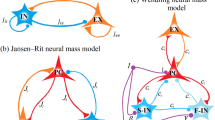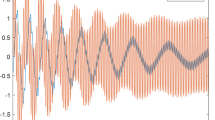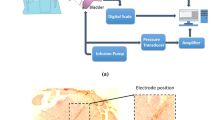Abstract
The chaotic nature of the brain can be observed by electroencephalogram signals. This chaotic behavior can be affected by the progressive nature of neurodegenerative disorders like Parkinson disease. The gradual changes in dynamical behavior of brain can be tracked to facilitate effective and timely treatment. Deep brain stimulation (DBS) is used in therapy when the medication stops working. We investigate the use of chaotic signal as stimulus in DBS. We stimulate a simulated model of isolated neuron with different types of stimuli to see if periodicity in neuronal spiking can be disrupted and show that neuron, when stimulated with chaotic signal, does fire up in non-periodic/chaotic manner. Furthermore, as a step toward the development of our system for estimation of chaotic behavior of brain, we investigate the use of recurrent neural networks to adapt the chaotic characteristics of a chaotic time series in this research work. We explore two different setups of long short-term memory (LSTM). In first setup, we define three unique topologies of LSTM network and analyze those for chaotic parameter estimation in seven different test cases for shallow and deep networks. We show that the deep LSTM networks are capable of modeling the chaotic behavior of a wide range of parameters and that the network performs the best when the architecture is driven by chaotic attributes of the time series data. In second setup, we use LSTM network in a traditional configuration to predict the chaotic time series data and demonstrate that the LSTM network can make prediction over a range of chaotic parameters with adequate accuracy. This provides the basis for the generation of chaotic stimulation signals when required.



















Similar content being viewed by others
References
Moreno-Valenzuela, J., Torres-Torres, C.: Adaptive chaotification of robot manipulators via neural networks with experimental evaluations. Neurocomputing 182, 56–65 (2016). https://doi.org/10.1016/j.neucom.2015.11.085
Munir, F.A., Zia, M., Mahmood, H.: Designing multi-dimensional logistic map with fixed-point finite precision. Nonlinear Dyn. 97(4), 2147–2158 (2019). https://doi.org/10.1007/s11071-019-05112-4
Hafstein, S.F., Valfells, A.: Efficient computation of Lyapunov functions for nonlinear systems by integrating numerical solutions. Nonlinear Dyn. 97(3), 1895–1910 (2019). https://doi.org/10.1007/s11071-018-4729-5
Restrepo, J.F., Schlotthauer, G.: Automatic estimation of attractor invariants. Nonlinear Dyn. 91(3), 1681–1696 (2018). https://doi.org/10.1007/s11071-017-3974-3
Jia, Y., Gu, H.: Identifying nonlinear dynamics of brain functional networks of patients with schizophrenia by sample entropy. Nonlinear Dyn. 96(4), 2327–2340 (2019). https://doi.org/10.1007/s11071-019-04924-8
Lotte, F.: A tutorial on EEG signal-processing techniques for mental-state recognition in brain–computer interfaces. In: Miranda ER, Castet J (eds.) Guide to Brain-Computer Music Interfacing, pp. 133–161. Springer (2014)
Pfurtscheller, G., Neuper, C.: Motor imagery and direct brain-computer communication. Proc. IEEE 89(7), 1123–1134 (2001)
Falahian, R., Dastjerdi, M.M., Molaie, M., Jafari, S., Gharibzadeh, S.: Artificial neural network-based modeling of brain response to flicker light. Nonlinear Dyn. 81(4), 1951–1967 (2015)
Lainscsek, C., Weyhenmeyer, J., Hernandez, M.E., Poizner, H., Sejnowski, T.J.: Non-linear dynamical classification of short time series of the Rössler system in high noise regimes. Front. Neurol. 4, 182 (2013)
Stam, C.J.: Nonlinear dynamical analysis of EEG and MEG: review of an emerging field. Clin. Neurophysiol. 116(10), 2266–2301 (2005)
Takens, F.: Detecting strange attractors in turbulence. In: Rand D, Young L-S (eds.) Dynamical Systems and Turbulence, Warwick 1980, pp. 366–381. Springer (1981)
Kennel, M.B., Brown, R., Abarbanel, H.D.: Determining embedding dimension for phase-space reconstruction using a geometrical construction. Phys. Rev. A 45(6), 3403 (1992)
Fraser, A.M., Swinney, H.L.: Independent coordinates for strange attractors from mutual information. Phys. Rev. A 33(2), 1134 (1986)
Ramasubbu, R., Lang, S., Kiss, Z.H.: Dosing of electrical parameters in deep brain stimulation (DBS) for intractable depression: a review of clinical studies. Front. Psychiatry 9, 302 (2018)
Rizzone, M., Lanotte, M., Bergamasco, B., Tavella, A., Torre, E., Faccani, G., Melcarne, A., Lopiano, L.: Deep brain stimulation of the subthalamic nucleus in Parkinson’s disease: effects of variation in stimulation parameters. J. Neurol. Neurosurg. Psychiatry 71(2), 215–219 (2001)
Gorman, P.H., Mortimer, J.T.: The effect of stimulus parameters on the recruitment characteristics of direct nerve stimulation. IEEE Trans. Biomed. Eng. BME–30(7), 407–414 (1983)
Grill, W., Mortimer, J.T.: The effect of stimulus pulse duration on selectivity of neural stimulation. IEEE Trans. Biomed. Eng. 43(2), 161–166 (1996)
Kuncel, A.M., Cooper, S.E., Wolgamuth, B.R., Clyde, M.A., Snyder, S.A., Montgomery Jr., E.B., Rezai, A.R., Grill, W.M.: Clinical response to varying the stimulus parameters in deep brain stimulation for essential tremor. Mov. Disord. 21(11), 1920–1928 (2006)
Koeglsperger, T., Palleis, C., Hell, F., Mehrkens, J.H., Bötzel, K.: Deep brain stimulation programming for movement disorders: current concepts and evidence-based strategies. Front. Neurol. 10, 410 (2019). https://doi.org/10.3389/fneur.2019.00410
Montgomery Jr., E.B.: Microelectrode targeting of the subthalamic nucleus for deep brain stimulation surgery. Mov. Disord. 27(11), 1387–1391 (2012)
van den Heuvel, M.P., Pol, H.E.H.: Exploring the brain network: a review on resting-state FMRI functional connectivity. Eur. Neuropsychopharmacol. 20(8), 519–534 (2010). https://doi.org/10.1016/j.euroneuro.2010.03.008
Kahan, J., Urner, M., Moran, R., Flandin, G., Marreiros, A., Mancini, L., White, M., Thornton, J., Yousry, T., Zrinzo, L., Hariz, M., Limousin, P., Friston, K., Foltynie, T.: Resting state functional MRI in Parkinson’s disease: the impact of deep brain stimulation on ‘effective’ connectivity. Brain 137(4), 1130–1144 (2014). https://doi.org/10.1093/brain/awu027
Kahan, J., Mancini, L., Flandin, G., White, M., Papadaki, A., Thornton, J., Yousry, T., Zrinzo, L., Hariz, M., Limousin, P., Friston, K., Foltynie, T.: Deep brain stimulation has state-dependent effects on motor connectivity in Parkinson’s disease. Brain 142(8), 2417–2431 (2019). https://doi.org/10.1093/brain/awz164
Baysal, V., Saraç, Z., Yilmaz, E.: Chaotic resonance in Hodgkin–Huxley neuron. Nonlinear Dyn. 97(2), 1275–1285 (2019). https://doi.org/10.1007/s11071-019-05047-w
Nobukawa, S., Nishimura, H., Yamanishi, T., Liu, J.Q.: Chaotic states induced by resetting process in Izhikevich neuron model. J. Artif. Intell. Soft Comput. Res. 5(2), 109–119 (2015)
Nobukawa, S., Nishimura, H., Yamanishi, T., Liu, J.Q.: Analysis of chaotic resonance in Izhikevich neuron model. PLoS ONE 10(9), 1–22 (2015). https://doi.org/10.1371/journal.pone.0138919
Reilly, J.P., Freeman, V.T., Larkin, W.D.: Sensory effects of transient electrical stimulation–evaluation with a neuroelectric model. IEEE Trans. Biomed. Eng. 12, 1001–1011 (1985)
Wang, L., Li, Lp: An effective hybrid quantum-inspired evolutionary algorithm for parameter estimation of chaotic systems. Expert Syst. Appl. 37(2), 1279–1285 (2010)
Wang, L., Xu, Y.: An effective hybrid biogeography-based optimization algorithm for parameter estimation of chaotic systems. Expert Syst. Appl. 38(12), 15103–15109 (2011)
Tao, C., Zhang, Y., Du, G., Jiang, J.J.: Estimating model parameters by chaos synchronization. Phys. Rev. E 69(3), 036204 (2004)
Jafari, S., Sprott, J.C., Pham, V.T., Golpayegani, S.M.R.H., Jafari, A.H.: A new cost function for parameter estimation of chaotic systems using return maps as fingerprints. Int. J. Bifurc. Chaos 24(10), 1450134 (2014)
Han, M., Xu, M., Liu, X., Wang, X.: Online multivariate time series prediction using SCKF-\(\gamma \)ESN model. Neurocomputing 147, 315–323 (2015)
Yeo, K.: Model-free prediction of noisy chaotic time series by deep learning. arXiv preprint arXiv:1710.01693 (2017)
Sim4life by ZMT: Sim4life simulator (2019). http://www.zurichmedtech.com
Grossman, N., Bono, D., Dedic, N., Kodandaramaiah, S.B., Rudenko, A., Suk, H.J., Cassara, A.M., Neufeld, E., Kuster, N., Tsai, L.H., Pascual-Leone, A.: Noninvasive deep brain stimulation via temporally interfering electric fields. Cell 169(6), 1029–1041 (2017)
Acknowledgements
This research work is funded by University of Regina Brain Research grant. This funding was donated to University of Regina by an anonymous donor in November 2015. The neuron simulations are conducted using Sim4Life by ZMT simulator.
Author information
Authors and Affiliations
Corresponding author
Ethics declarations
Conflict of interest
The authors declare that they have no conflict of interest.
Additional information
Publisher's Note
Springer Nature remains neutral with regard to jurisdictional claims in published maps and institutional affiliations.
Rights and permissions
About this article
Cite this article
Shah, S.A.A., Bais, A. & Zhang, L. Adaptation of dynamical properties of time series data and its applications in deep brain stimulation. Nonlinear Dyn 99, 3231–3251 (2020). https://doi.org/10.1007/s11071-019-05453-0
Received:
Accepted:
Published:
Issue Date:
DOI: https://doi.org/10.1007/s11071-019-05453-0




